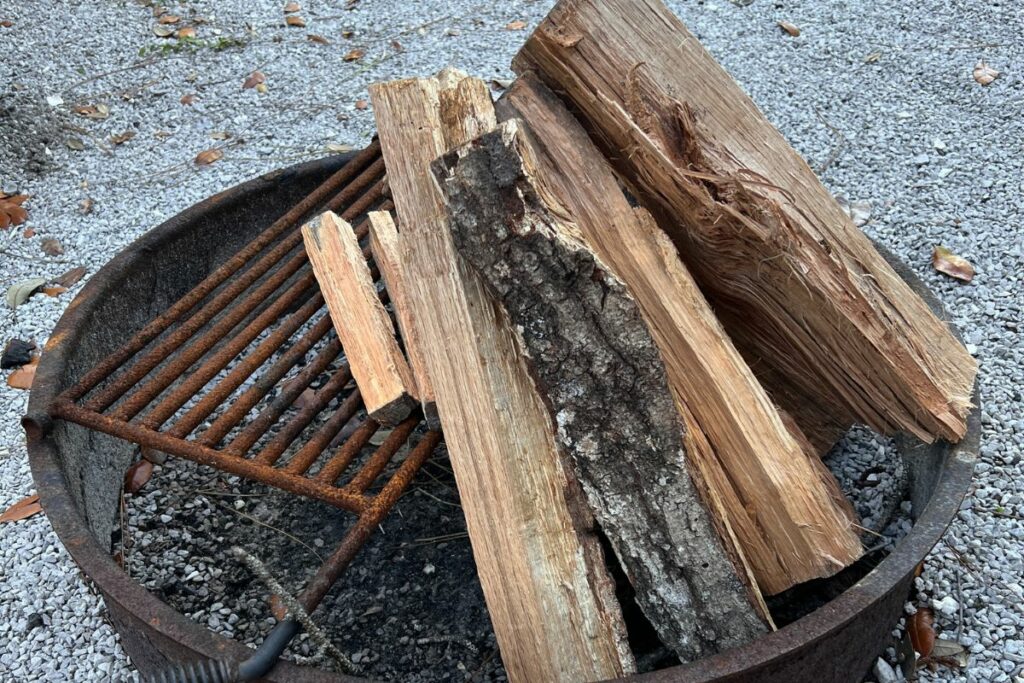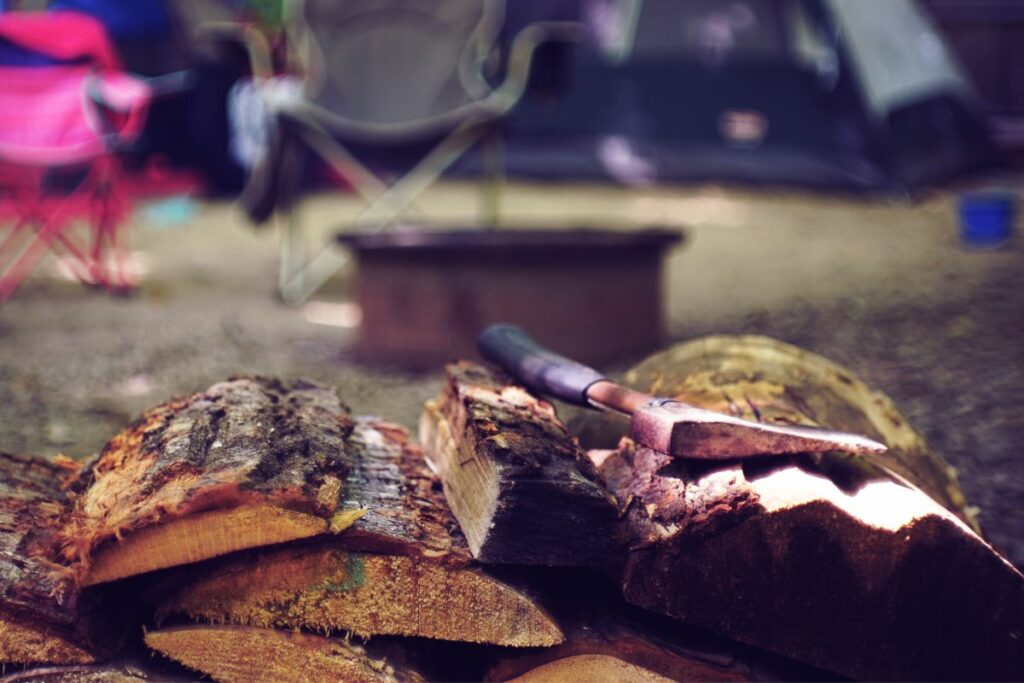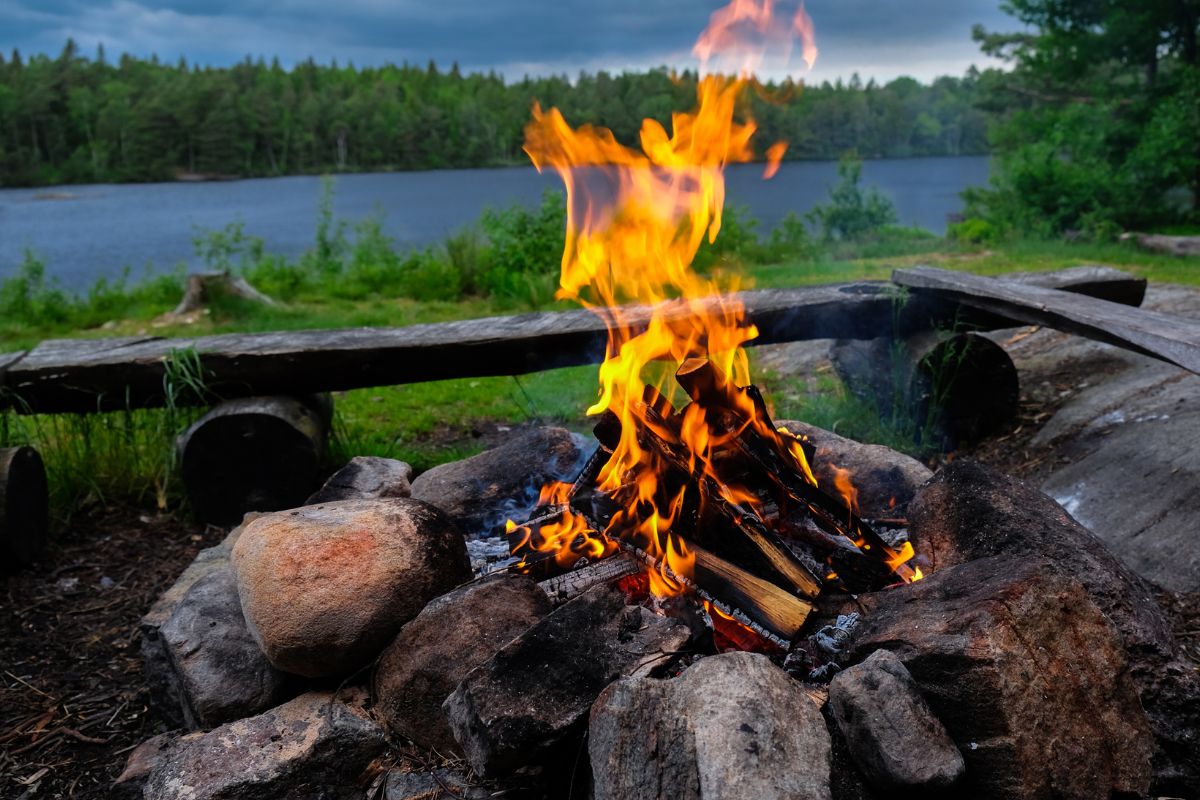Building a fire is one of my favorite parts of any camping trip. I love the process of collecting kindling, carefully stacking the firewood, and then watching as the embers grow into a roaring flame.
I love gathering around it with friends to tell ghost stories, sing some songs, and make smores. And I love preparing my favorite camping meals over the open flame.
After all my years of camping and building campfires, I’ve developed an easy to follow formula that determines how much firewood I need for camping trips of all kinds.
I’ll start by sharing my basic formula and then explain how I developed my formula and then discuss the factors to consider to figure out your exact firewood needs for your next camping trip.
Table Of Contents
How Much Firewood Do I Need For Camping?
The basic guideline I recommend is to bring 8 bundles of firewood per day of camping. I typically include 5 logs in each bundle but it can vary between 4-6 depending on how big or small each log is. A bundle is basically the amount of wood I can carry in my arms at one time or if you want to get technical (I don’t) then it’s 1 cubic ft of wood.
That will be enough firewood for most campers and will be enough wood to both cook over as well as provide warmth and nighttime entertainment.
Factors That Determine Your Firewood Needs
My formula works for your basic car camping trip to a state park with a 3ft fire ring. The formula also assumes you’ll have a fire going for 3-4 hours a night and 1-2 hours each morning.
Obviously, your needs could be much different than that so let’s take a closer look at all the factors that will impact exactly how much firewood you should bring on your next camping trip.

Duration Of The Camping Trip
The longer you’ll be camping the more firewood you’ll need, and to be honest I felt like Captain Obvious as I typed that out. Clearly you’ll need more firewood for 2 nights of camping than you would for one night…no duh right?!
Joking aside, as long as your needs will be fairly consistent from day to day you should be able to simply figure out your daily needs based on the other factors I’ll discuss next, and then multiply that by the number of days you’ll be camping.
But, I do recommend that you consider that your needs might not be the same each day. Some days you may want to cook a hot breakfast and others you might want to go for an easier no-cook breakfast option, which means you may not want to go to the trouble of building a campfire that morning.
The basic rule: Be mindful of your daily firewood needs and determine if they will be the same from day to day.
Number Of People In Your Group
The number of people in your group can impact your needs as well, especially if you’re camping in a large group and want to have a larger fire that everyone can gather around.
But, I wouldn’t go overboard and be mindful that many campsites are going to have a limit on how big of fire you can build.
My basic formula of 8 bundles per day is good for groups of up to 5 campers, beyond that you may want to add a few more.
Weather Conditions And Climate
Weather conditions and climate play a significant role in determining how much firewood you’ll need for camping.
For instance, if you’re camping during colder months or in higher altitudes, you can expect to burn more wood to keep warm and maintain a comfortable temperature around your campsite. In such situations, it might be necessary to double the amount of firewood compared to what is needed during warmer seasons.
During milder weather conditions you may not require as much firewood since the primary purpose of your campfire could be cooking or simply creating an ambient atmosphere.
It’s essential to check local forecasts leading up to your trip so that you can properly gauge the type and amount of firewood required for your specific needs.
Related: Camping In The Rain: How To Thrive (Not Just Survive)
Type Of Wood
Hardwoods like hickory or oak will burn hotter and for longer than softer woods like pine or fir. Pay attention to the type of wood that is available in your area and consider getting a few extra bundles if the only choices available to you are softwood varieties.
Cooking Needs
If you plan on cooking all of your meals over an open fire then I recommend bringing 3-5 more bundles each day than you would if you’re not planning to cook.
Making sure your fire is hot enough and burns long enough to properly prepare your food is too important of a factor to get wrong so I try to err on the side of caution and bring more than I need.
Where To Get Firewood For Camping
You can find firewood for camping at campgrounds, local suppliers, or by foraging in the woods.

At Your Campground
When camping, one of the easiest ways to get firewood is through campgrounds. Many campsites have designated areas where you can purchase bundles of firewood for a reasonable price. This option is especially convenient if you’re traveling to an area that prohibits bringing in outside wood due to invasive species concerns.
However, keep in mind that not all campgrounds offer firewood for sale. If this is the case, be sure to research local stores ahead of time or consider gathering your own firewood from the surrounding area (if permitted). Additionally, some campgrounds may prohibit gathering deadfall or cutting down trees for firewood.
Local Firewood Suppliers
One option for obtaining firewood for camping is through local suppliers. These businesses offer a convenient solution for those who don’t have the time, equipment, or desire to gather their own wood.
A quick online search or inquiry at a nearby outdoor store can help you find these providers. Or in my area local firewood dealers start lining up alongside busy highways each fall and I simply pull over, hand the man some cash, and he fills up my truck bed for wood.
Gathering Firewood In The Woods
This can be a fun and rewarding experience, but it’s important to know what you’re doing to avoid damaging the environment or disrupting wildlife habitats. Before collecting any wood, make sure that it is legal to do so in the area you’re camping in, as some places may have restrictions on removing natural resources.
When searching for firewood in the woods, look for dead or fallen trees that are dry and seasoned. Avoid cutting down living trees or branches, as this can harm the ecosystem and disrupt animal habitats. It’s also important to leave no trace by minimizing impact on the surrounding environment and avoiding disturbing vegetation.
Best Practices For Storing And Using Firewood
If you’re buying your firewood right before you go camping then make sure it’s cured and ready to burn. And if you’re collecting firewood at home or storing it for long timeframes, then follow these tips.
Choosing And Preparing Firewood
When selecting your firewood, consider factors like burn time and heat output. Hardwoods such as oak and hickory burn longer and produce more heat than softwoods like pine. It’s important to keep in mind that different regions have their own preferred types of wood. For example, birch or maple are good options for campfire fuel in the Northeast while mesquite or piñon are popular choices in the Southwest.
To prepare your firewood, it’s recommended to split larger logs into smaller pieces using an axe or saw. This will make them easier to light and burn evenly. If you’re bringing pre-cut firewood from home, be sure it’s dry and seasoned before packing it up for your trip. Wet or green wood can be difficult to ignite and may not burn properly.
Keeping Firewood Dry And Covered
Keeping firewood dry is crucial for ensuring that it burns easily and efficiently. Moisture in the wood can lead to difficulty starting a fire or cause it to smolder rather than burn brightly. To keep your firewood dry, it’s essential to cover it with a tarp or other weather-resistant material. You can also elevate the wood off the ground by placing it on pallets or other raised surfaces.
It’s important to consider where you store your firewood as well. Ideally, you should keep it in a covered area such as a shed or garage until you’re ready to use it. If you must store your wood outdoors, make sure that there is adequate ventilation around the pile so that air can circulate and help dry out any moisture that may be present.
Fire Safety And Leave No Trace Principles
Fire safety and Leave No Trace principles are essential when camping with a fire. Before starting a campfire, ensure that you have the necessary permits and check for any current fire restrictions in the area. Choose a safe location that is away from any flammable materials such as dry grass or overhanging branches. Make sure to clear the surrounding area of any debris and rocks.
When building your fire, start small with kindling before gradually adding larger pieces of wood. Always keep water nearby in case of an emergency, and never leave the campfire unattended. When it’s time to put out the fire, use water to extinguish it completely until there are no more smoking embers or warm ashes.
Firewood Alternatives
There are a few alternative fuel sources that can be used for camping. For example, propane stoves and portable gas grills are an easy option for cooking food without using wood. These types of appliances can be easily transported to the campsite and provide consistent heat output.
Another option is charcoal briquettes or lump charcoal, which produce less smoke than wood and can also be burned in a designated fire pit or grill. Additionally, if you have access to dry leaves or pine needles, they can be used as kindling to start a fire without needing full-sized logs.
However, it’s important to note that some campsites may have restrictions on using alternative fuel sources due to environmental considerations or fire safety regulations. Always check with the campground before planning your trip so that you know what types of fuels are allowed.
Camping Firewood FAQs
Should I buy seasoned or unseasoned firewood for camping?
Whenever possible, it is best to opt for seasoned wood that has been dried properly as it burns more efficiently with less smoke and sparks than unseasoned wood which can produce excess moisture leading to poor combustion quality.
Can I collect dead branches from within the campsite area for use as firewood?
Before collecting any wood onsite make sure that it does not violate park policies or regulations against gathering natural resources such as kindling material! If there aren’t laws prohibiting this practice then feel free as long as you follow Leave No Trace guidelines and ensure anything you pick up is dead and not home to any living creatures.

